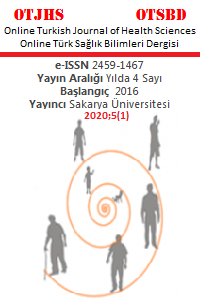Abstract
Objective: Our
aim in this research is to evaluate the laboratory productivity commission (LPC)
studies of Sakarya University Training and Research Hospital (SUEAH) in terms
of laboratory cost analysis.
Materials and Meyhods: Our method for
laboratory productivity analysis is to evaluate the commission studies
statistically in terms of cost analysis by retrospectively scanning the data
six months before and six months after the establishment of the LPC through
automation. The tests to be examined in the study are; Folate, Estradiol,
Ferritin, follicle stimulating hormone (FSH), Progesterone, Prolaktin, total
prostatic antigen (Total PSA), thyroxine
3 (T3), thyroxine 3 (T4), alpha fetoprotein (AFP),
anti-thyroglobulin, anti thyroid peroxidase (Anti TPO), beta hCG, C-peptide, CA
125, CA 15-3, CA 19-9, carcino embryonic antigen (CEA), dehydro-epi androstenedione sulfate (DHEA-sulphate), thyroid stimulant hormone (TSH),
sex hormone binding globulin (SHBG), Vit B12.
Results: All
of the tests that were run were found to decrease in the number of requests.
However, the decrease in some tests was noteworthy. The highest number of
requests from these tests is the T3 test with a decreasing 42,19%. If the
minimum number of requests is decreasing, the C-peptide is at a rate of 3,22%.
Conclusion: The
first data obtained from LPC studies show that; a very serious amount of
unnecessary and test requests in hospitals are available in the hospital
information management system (HIMS). This situation can be corrected by the
LPC to be established.
Keywords
Automation cost analysis laboratory productivity commission number of test requests productivity
References
- 1. Gençtürk M, Cansever İH. Üniversite Hastanelerinin Faturalama Sürecindeki Sorunları Üzerine Bir Araştırma. Hacettepe Sağlık İdaresi Dergisi. 2016; 19: 225-239.
- 2. Erkol Ü, Ağırbaş İ. Hastanelerde Maliyet Analizi ve Faaliyet Tabanlı Maliyetleme Yöntemine dayalı Bir Uygulama. Ankara Üniversitesi Tıp Fakültesi Mecmuası. 2011; 64: 2.
- 3. Akar Ç. “Hastane İşletmelerinde Yönetim Muhasebesi” Doktora Tezi. Gazi Üniversitesi Sosyal Bilimler Enstitüsü. 1992; Ankara.
- 4. Menderes M. “Hastanelerde Muhasebe, Maliyetleme Sorunları ve Finansal Yönetim”. Toplum ve Hekim. 1995; 10: 69 –70.
- 5. Bursal N. Ercan Y. Maliyet Muhasebesi İlkeler ve Uygulama. İstanbul Üniversitesi İşletme Fakültesi Muhasebe Enstitüsü Yayınları. 1991; 58: 3.
- 6. Ağırbaş İ. Hastanelerde maliyet-performans analizi ve TCDD Ankara Hastanesinde bir uygulama. H. Ü. Sağlık Bilimleri Enstitüsü. 1993; 3: 8.
- 7. Mut S, Ağırbaş İ. Hastanelerde Maliyet Analizi: Ankara’da Hizmet Sunan Ikinci Basamak Bir Kamu Hastanesi’nde Uygulama. Mehmet Akif Ersoy Üniversitesi, Sosyal Bilimler Enstitüsü Dergisi. 2017; 18: 202-217.
- 8. Ağırbaş İ, Gök HA, Yasemin Ö, Ömer R. Hastanelerde Maliyet Analizi ve Tıbbi Rehabilitasyon Hizmetlerinde Birim Maliyet Hesaplanması. Türkiye Fiziksel Tıp ve Rehabilitasyon Dergisi. 2012; 58: 103-108.
- 9. Erbil M.K. “Liderlik ve Laboratuvar Yönetimi”. Türk Biyokimya Dergisi. 2007; 32: 3.
Abstract
Amaç: Bu araştırmada amacımız, Sakarya Üniversitesi Eğitim ve Araştırma
Hastanesi (SÜEAH) laboratuvar verimlilik komisyon (LVK) çalışmalarının,
laboratuvar maliyet analizi açısından değerlendirilmesidir.
Materyal ve Metod: Laboratuvar verimlilik analizi için metodumuz, LVK’nın kuruluş tarihinden altı ay öncesi ve
altı ay sonrası verileri otomasyon üzerinden geriye dönük tarayarak, komisyon
çalışmalarını maliyet analizi açısından istatistiksel olarak değerlendirmektir.
Çalışmada incelenecek olan testler şu şekilde belirlenmiştir; Alfa feto protein (AFP), anti tiroglobulin, anti tiroid peroksidaz (Anti TPO), beta
hCG, C-peptid, CA 125, CA 15-3, CA 19-9, karsino
embriyonik antijen (CEA), dehidro-epi androstenedion
sulfat (DHEA-sülfat), Folat, Estradiol, Ferritin, folikül stimülan hormon (FSH), Progesteron, Prolaktin, total prostatik antijen (Total PSA),
tiroksin 3 (T3), tiroksin 4 (T4), tiroid stimülan
hormon (TSH), seks hormonu bağlayıcı
globülin (SHBG), Vit B12.
Bulgular: Çalışılan tüm testlerin istem sayılarında azalma olduğu görülmüştür.
Ancak bazı testlerdeki azalma dikkat çekici bulunmuştur. Bu testlerden en fazla
istem sayısı azalan %42,19 oranı ile T3
testidir. En az istem sayısı azalan ise,
%3,22 oranı ile C-peptid olmuştur.
Sonuç: LVK çalışmalarından elde edilen veriler göstermektedir ki;
hastanelerde önemli miktarda gereksiz ve test istemleri hastane bilgi yönetim
sisteminde (HBYS) mevcuttur. Bu durum kurulacak LVK’ları tarafından
düzeltilebilir niteliktedir.
References
- 1. Gençtürk M, Cansever İH. Üniversite Hastanelerinin Faturalama Sürecindeki Sorunları Üzerine Bir Araştırma. Hacettepe Sağlık İdaresi Dergisi. 2016; 19: 225-239.
- 2. Erkol Ü, Ağırbaş İ. Hastanelerde Maliyet Analizi ve Faaliyet Tabanlı Maliyetleme Yöntemine dayalı Bir Uygulama. Ankara Üniversitesi Tıp Fakültesi Mecmuası. 2011; 64: 2.
- 3. Akar Ç. “Hastane İşletmelerinde Yönetim Muhasebesi” Doktora Tezi. Gazi Üniversitesi Sosyal Bilimler Enstitüsü. 1992; Ankara.
- 4. Menderes M. “Hastanelerde Muhasebe, Maliyetleme Sorunları ve Finansal Yönetim”. Toplum ve Hekim. 1995; 10: 69 –70.
- 5. Bursal N. Ercan Y. Maliyet Muhasebesi İlkeler ve Uygulama. İstanbul Üniversitesi İşletme Fakültesi Muhasebe Enstitüsü Yayınları. 1991; 58: 3.
- 6. Ağırbaş İ. Hastanelerde maliyet-performans analizi ve TCDD Ankara Hastanesinde bir uygulama. H. Ü. Sağlık Bilimleri Enstitüsü. 1993; 3: 8.
- 7. Mut S, Ağırbaş İ. Hastanelerde Maliyet Analizi: Ankara’da Hizmet Sunan Ikinci Basamak Bir Kamu Hastanesi’nde Uygulama. Mehmet Akif Ersoy Üniversitesi, Sosyal Bilimler Enstitüsü Dergisi. 2017; 18: 202-217.
- 8. Ağırbaş İ, Gök HA, Yasemin Ö, Ömer R. Hastanelerde Maliyet Analizi ve Tıbbi Rehabilitasyon Hizmetlerinde Birim Maliyet Hesaplanması. Türkiye Fiziksel Tıp ve Rehabilitasyon Dergisi. 2012; 58: 103-108.
- 9. Erbil M.K. “Liderlik ve Laboratuvar Yönetimi”. Türk Biyokimya Dergisi. 2007; 32: 3.
Details
| Primary Language | Turkish |
|---|---|
| Subjects | Health Care Administration |
| Journal Section | Research article |
| Authors | |
| Publication Date | March 31, 2020 |
| Submission Date | September 13, 2018 |
| Acceptance Date | February 29, 2020 |
| Published in Issue | Year 2020 Volume: 5 Issue: 1 |



